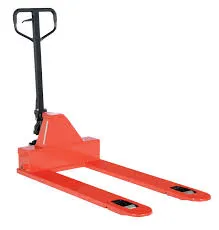


The Benefits of Pedestrian-Powered Pallet Trucks A Solution for Modern Warehousing
In today's fast-paced logistics and warehousing environments, efficiency and ease of movement are essential for maintaining productivity. One innovative solution that has gained popularity is the pedestrian-powered pallet truck. This equipment is not only a boon for warehouse operations but also an environmentally friendly option that meets the challenges of modern supply chains.
What is a Pedestrian-Powered Pallet Truck?
A pedestrian-powered pallet truck is a manual or semi-electric device designed to lift and transport pallets within warehouses, retail environments, and loading docks. Unlike ride-on trucks, these units require an operator to walk alongside or behind them, ensuring a compact design that maximizes maneuverability in tight spaces. Most pedestrian-powered pallet trucks come equipped with features such as ergonomic handles, powered lifting mechanisms, and high-capacity forks, which enhance their functionality and user-friendliness.
Enhanced Safety Features
Safety is one of the primary concerns in any industrial setting, and pedestrian-powered pallet trucks are designed with this in mind. These trucks typically feature low-profile designs to reduce the risk of tipping and provide a stable platform for heavy loads. Additionally, many models incorporate safety alarms and dead-man switches that automatically stop the truck when the operator releases the handle, minimizing the risk of accidents.
Moreover, the ability to navigate tight spaces safely means fewer collisions with workers or obstacles, further enhancing workplace safety. This focus on safety not only protects employees but also reduces the potential for costly damage to goods and equipment.
Environmental Sustainability
As businesses increasingly focus on sustainability, pedestrian-powered pallet trucks shine as an eco-friendly alternative to gas-powered vehicles. Many models utilize electric batteries for lifting, which significantly reduces carbon emissions. Furthermore, the absence of a combustion engine means less noise pollution, creating a quieter work environment that benefits both employees and nearby communities.

By utilizing pedestrian-powered pallet trucks, companies can demonstrate their commitment to environmentally responsible practices, making these trucks an attractive option for businesses looking to enhance their green credentials.
Cost-Effectiveness
When considering the operating costs of a warehouse, many factors come into play, from maintenance to energy consumption. Pedestrian-powered pallet trucks are often more cost-effective than their larger, ride-on counterparts. They not only have lower initial purchase prices but also incur fewer maintenance costs due to their simpler mechanical design.
Additionally, their energy efficiency reduces utility expenses associated with charging electric models. As these trucks are lighter and more compact, they often require less physical effort from operators, leading to higher productivity rates and reduced fatigue.
Versatility and Space Efficiency
One of the standout benefits of pedestrian-powered pallet trucks is their versatility. They are perfect for various applications, from moving heavy pallets of goods to retrieving items from shelves. Their compact design allows them to maneuver seamlessly in narrow aisles, making them an ideal choice for warehouses with limited space.
Moreover, these trucks are suitable for various surfaces, including concrete, asphalt, and even uneven terrains. As a result, businesses can confidently use pedestrian-powered pallet trucks in diverse environments, from warehouses to retail settings.
Conclusion
In an era where efficiency, safety, and sustainability are paramount, pedestrian-powered pallet trucks emerge as an excellent solution for modern warehousing needs. By offering enhanced safety features, environmental benefits, cost-effectiveness, and exceptional versatility, they cater to the demands of today’s dynamic supply chains. Companies looking to optimize their operations should seriously consider integrating these innovative tools into their logistics strategies, reaping the myriad benefits they bring to the table.



